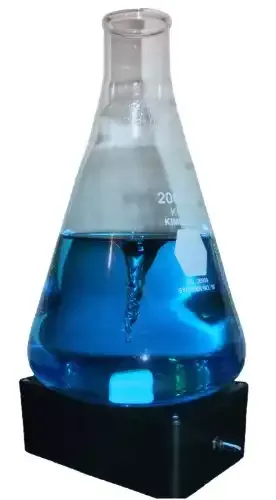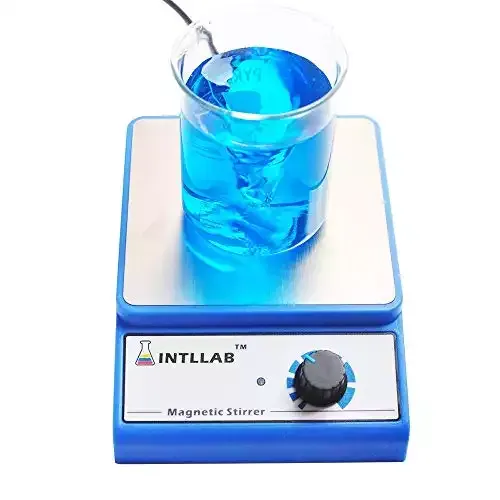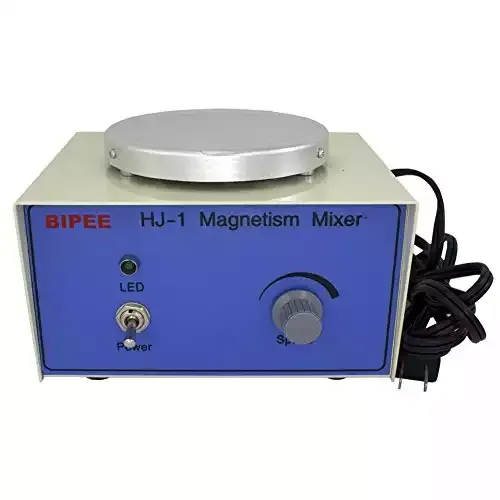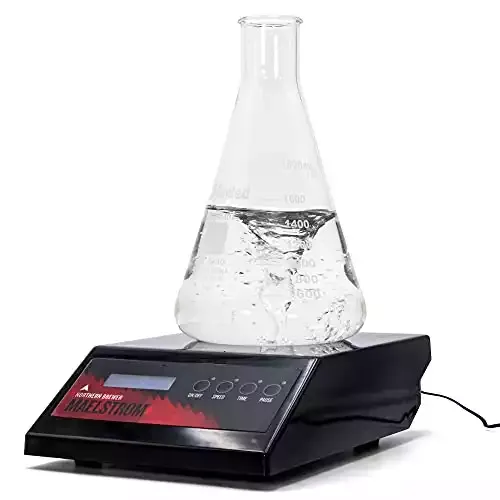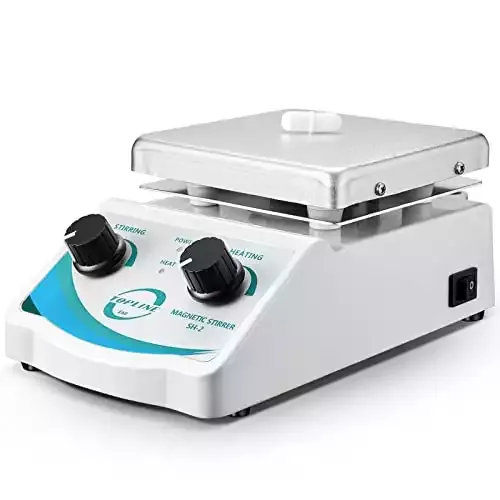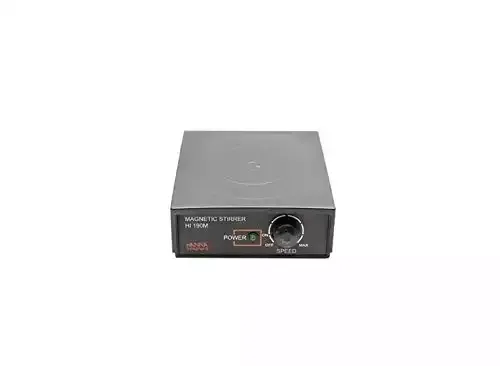All healthy fermentations start with healthy yeast. To give your beer the best chance of fully fermenting with no off-flavors, you need to pay attention to yeast health and pitch rate. Stir plates are the most efficient and effective tool you can use to make sure you’re brewing with the best yeast.
Stir plates are used to quickly make healthy yeast starters. Through constant stirring, stir plates introduce oxygen and keep yeast in suspension. This ensures healthy yeast growth and an adequate pitch rate. The best stir plate for homebrewers is the Maelstrom because of its power, durability, and timer functionality. If you’re on a budget, we recommend the StirStarter for a straight-forward stir plate that’s reliable and efficient.
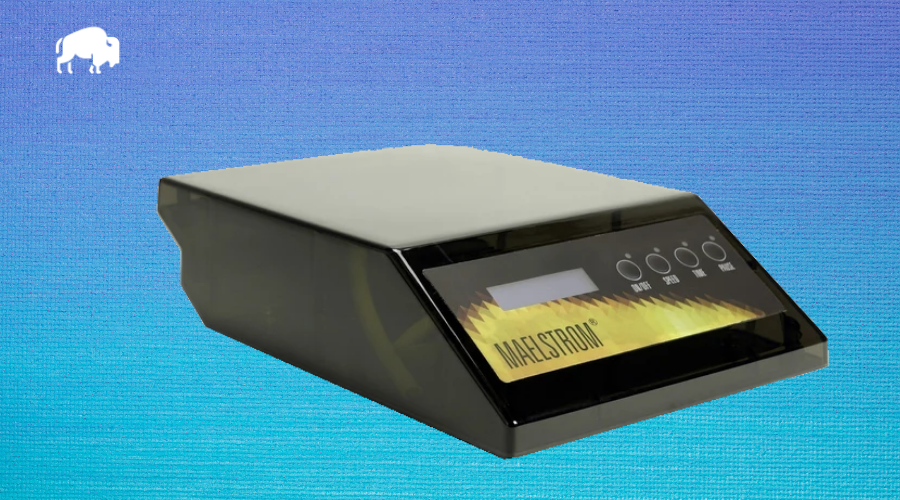
Let’s dive right into the stir plate reviews. For a complete overview of the background behind stir plates, keep reading until the bottom.
StirStarter
This simple stir plate helps you culture higher cell counts of healthy yeast for quality fermentations.
Simple and effective, the StirStarter is a great choice for a no-nonsense, budget friendly stir plate. Its basic design and ease of use make this option a great choice for most homebrewers. We highly recommend this stir plate if you’re looking for a work-horse stir plate that won’t break the bank.
| Pros | Cons |
| Good value | Limited starter volume size |
| Very simple design |
Features:
- Compact footprint
- Simple speed control
- Up to 2L starters
- Includes stir bar and keeper magnet
Where to buy: Amazon
INTLLAB Magnetic Stir Plate
This magnetic stirrer is ideal for stirring in scientific research, industry, agriculture, health, medicine, and homebrewing. It comes with a 7mm x 30mm stir bar.
As the most economical stir plate on our list, the INTLLAB Magnetic Stir Plate is an enticing offer. Rudimentary in design and with a minimal build quality, this stir plate has a few known quality issues. The magnet is weak which may cause the stir bar to stop spinning. The device’s longevity is also limited due to poorer material selection. Overall, the INTLLAB stir plate should get the job done but the risk of a poorly operating or faulty machine is high.
| Pros | Cons |
| Great price | Poor build quality |
| Simplistic design | Known issues due to weak magnet |
Features:
- Speed control dial between 0 to 3000 rpm
- 3L volume stirring capacity
- Magnetic stir bar (7*30mm) included
Where to buy: Amazon
HJ-1 Magnetism Mixer
This magnetic stir plate uses magnetic fields to make a stir bar to spin to stir a solution.
The HJ-1 is a solid, mid-priced stir plate. We like this stir plate for its reliable operation and sturdy build. The appearance will also give your brew-space a retro science lab vibe.
| Pros | Cons |
| Robust build quality | Large size not ideal for storage and use in small spaces |
| Sturdy and wide footprint | |
| Precise speed control |
Features:
- Up to 3L stirring capacity
- Included stir bar
- On/off switch and precision speed control dial
- Thermometer or pH probe holder
Where to buy: Amazon, MoreBeer
Maelstrom
This is the first industrial-grade and programmable stir plate designed homebrewing and yeast starters.
Designed explicitly for brewers, the Maelstrom is a powerful stir plate with a few unique features. Programmable up to 48 hours, you can choose exactly when you want your starter to stop spinning. You can plan when you want the stir plate to finish, giving time for the yeast to settle before you pitch. There’s a convenient LED display that shows you how much time is left.
The Maelstrom is the best stir plate available for homebrewers and we highly recommend this device.
| Pros | Cons |
| Innovative timer feature | Overly complicated for some users |
| Huge range of starter volumes | Elevated price |
| Powerful motor |
Features:
- LED display showing timer and speed setting
- 5 different speed settings between 480 to 1440 RPM
- Translucent top so you can see the motor spinning
- Starters sizes from 1L flask all the way to a 5 gallon carboy
- Comes with stir bar and stir bar removal tool
Where to buy: Amazon
Faithful SH-2 Heated Magnetic Stirrer
A scientific-grade hotplate magnetic stirrer with stepless stirring speed adjustment and fast-heating element.
Some brewers like the option of having a heated stir plate. Giving the yeast a little heat when stirring can promote quicker growth. It can also help acclimate the yeast to a specific fermentation temperature. Although typically not necessary for yeast starters, there are a few heated stir plate options. The Faithful SH-2 is our recommendation for a heated stir plate. Functionally, this stir plate is well-built and easy to use. Due to the high price point, however, it’s not recommended unless you absolutely need a heating function.
| Pros | Cons |
| Adjustable heater | Higher price point |
| Sturdy and wide footprint | |
| Precise speed control |
Features:
- Adjustable heating feature
- Motor speed between 100 to 2000 rpm
- Make up to 5L starter
Where to buy: Amazon
Hanna 190M Stir Plate
The Hanna Instruments HI 190M-1 is a high-end magnetic stirrer that comes with a mini-stir bar.
Hanna makes great quality lab equipment for a number of industries. The 190M is a solid bet for a reliable stir plate. This is a small sized device, with a maximum rated stirring capacity of only 1 liter. For homebrew purposes, you could possibly go up to 2 liters. Although the device is compact, it’s well built, reliable, and sturdy
| Pros | Cons |
| Precise speed control | Expensive for what you get |
| Compact and easy to store | Small stirring volume capacity |
Features:
- Adjustable speed control dial
- Motor speed between 100 to 1000 rpm
- Make up to 1L starter
Where to buy: Amazon
What is a stir plate
A stir plate is a mechanical device that uses magnetism to stir liquids. For homebrewing, these are used exclusively for yeast starters.
A liquid containing vessel – usually a flask – is placed on top of the stir plate. A small magnetic stir bar is dropped in the liquid and spun in circles by the stir plate’s internal spinning magnet.
The spinning creates a vortex in the starter that continuously introduces oxygen into the solution. Stirring also keeps yeast in suspension. This constant oxygenation and agitation allows quick and healthy yeast growth.
What to look for in a stir plate
Simple is often better when choosing a stir plate. A stir plate is designed to do one job: stir! It’s best to keep any other mechanical components or electronics to a minimum to limit any potential problems.
Precision
When making yeast starters, you don’t need to create a strong vortex. In fact, all that is really needed is a light dimple on the top of the wort. Precise speed control will help dial in the ideal stirring rate, which may fluctuate depending on the starter.
Heating
A heating function is also common on stir plates. For homebrewing, heating is almost never required. Most yeast starters grow healthy yeast at room temperature. If you really want a heated stir plate, make sure to choose one with variable temperature adjustment. An uncontrolled heater can easily cook the yeast and kill it.
Stirring Volume
Stir plates come in a large range of sizes. Most starters you’ll be building will be at least 1L, so that is the minimum size we’d recommend.
Extras
Many stir plates come with a probe holder. This is usually a metal rod that extends vertically 6” to 12”. An attached clip holds measurement probes, like a thermometer or a pH meter. Constant measurements of yeast starters are almost never important. For homebrewing, the probe holder isn’t really an advantage or disadvantage so it shouldn’t sway your purchase decision.
When purchasing a stir plate, make sure it comes with a stir bar – the small magnet that gets spun inside the flask. Most stir plates come with at least one stir bar but it’s always good to double check the product description. In addition to the stir bar, some stir plates come with a small magnet to help retrieve the stir bar from the flask before pitching the yeast.
What are the benefits of using a stir plate
Stir plates are used to ensure efficient and healthy yeast growth when making yeast starters. We’ve covered how and why to use a yeast starter in our comprehensive guide. To recap, yeast starters:
- Increase yeast cell counts over 24-48 hours before pitching
- Acclimate yeast to the environment that it will ferment in
- Save you money and ensure you have healthy yeast to ferment your beer
- Prevent off-flavors caused by underpitching and stressed yeast
Using a stir plate to grow your starters makes the process much more efficient. Stir plates greatly increase healthy cell count to prepare yeast to pitch into your homebrew. Using a stir plate can help grow a lot of healthy yeast in a short amount of time.
Stir plates greatly help in growing starters from old yeast or commercial bottles. The oxygenation and agitation give any unhealthy yeast the added push to multiply and be ready to use in a 5 or 10 gallon batch. Culturing from bottles can be very useful when making clone beers.
Sometimes, yeast starters can ferment aggressively. A stir plate keeps the krausen from blowing out of the top as the continuous vortex pulls liquid and oxygen toward the centre. This vortex also helps drive off CO2 that’s produced during fermentation that could stress yeast.
Final Thoughts
Stir plates are a great addition to your arsenal of tools as a homebrewer. Stirring the yeast starter, continuously oxygenating and agitating, greatly improves yeast health. Stir plates will help you brew better beer because you’ll be pitching the healthiest yeast at exactly the right pitch rate.
We recommend the Maelstrom stir plate due to it’s solid build quality, ease of use, and consistent and easy to control stir mechanism. For a budget-friendly option, you can’t go wrong with the StirStarter.
If you’re serious about eliminating off-flavors from your homebrew, a stir plate will get you one step closer to the perfect pint.
Frequently Asked Questions
What type of flask should be used on stir plates?
The most common type of vessel used to make starters on stir plates is called an Erlenmeyer flask. These are the typical flasks you’d see in a chemistry lab.
Erlenmeyer flasks can be heat sanitized, are extremely durable, and have clear volume markings.
For homebrewers, a practical volume is 2 litres. With that size, you can easily make yeast starters for 5 or 10 gallons of wort.
How do I make a yeast starter?
To make a yeast starter, you’ll need dry malt extract (DME), water, yeast nutrient, and yeast. See our guide for the full procedure to get started.

